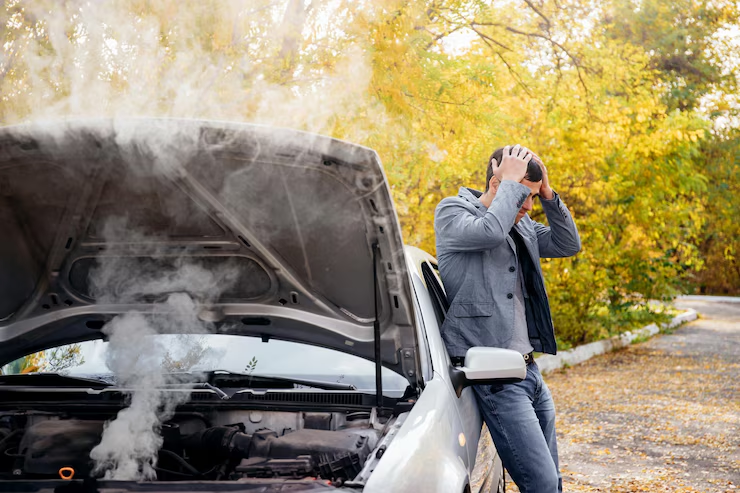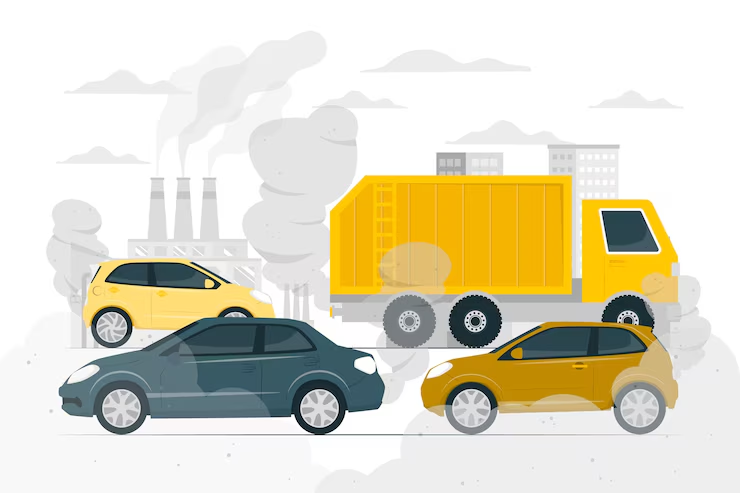
Why Does My Car Smell Like Gas?
A gas smell emanating from a car can be alarming and may indicate a serious issue requiring immediate attention. Common reasons for this odor include fuel leaks, a faulty fuel injection system, or issues with the fuel pressure regulator. Identifying the source promptly can prevent larger problems down the road and ensure safety while driving.
Drivers might notice a gas smell after refueling, which can stem from an improperly sealed fuel cap or overfilling the tank. In more severe cases, a worn fuel line or damaged fuel tank could be leaking gas, presenting a fire hazard. Understanding these causes is essential for maintaining vehicle health and safety.
Ignoring the smell can lead to increased fuel consumption and put the vehicle’s reliability at risk. Assessing whether the smell is constant or intermittent can help pinpoint the issue, guiding owners toward effective solutions.
Common Causes of Gasoline Odors in Cars

Gasoline odors in vehicles can arise from several sources. Identifying the cause is essential for proper resolution and safety. The following factors are among the most common contributors to these fuel smells.
Fuel Line Leaks
Fuel lines transport gasoline from the tank to the engine. Over time, these lines can develop cracks or holes due to wear and tear.
Signs of a fuel line leak include a strong gasoline smell near the engine or under the vehicle.
Drivers should inspect the area for puddles or wet spots. Repairing a fuel line typically involves replacing the affected section, which is critical to avoid fire hazards.
Loose or Faulty Gas Cap
A loose or damaged gas cap can lead to gasoline odors. If the cap is not sealed correctly, fuel vapors can escape.
Drivers might notice a gas smell after refueling or during driving.
Checking the gas cap for tightness and ensuring an intact rubber seal is important. Replacing the gas cap is a simple solution that can often eliminate the odor.
Evaporative Emission System Issues
The Evaporative Emission Control System (EVAP) captures fuel vapors from the gas tank. A malfunction in this system can result in gasoline odors.
Common problems include broken hoses, faulty purge valves, or damaged charcoal canisters.
If any components of the EVAP system are compromised, they can lead to vapor leaks. Addressing EVAP issues typically requires professional assistance, as it involves specialized components.
Oil or Fluid Leaks
While oil leaks do not directly involve gasoline, they can produce strong odors that may be confused with fuel smells.
Oil can leak from various engine components, such as the oil pan or gasket seals.
The heat from the engine can cause leaking oil to evaporate, releasing a burning smell.
Inspecting the engine for oil spots or low oil levels can help diagnose this issue. Repairing oil leaks is crucial for engine performance and safety.
Overfilled Engine Oil
An overfilled engine can also cause various smells, including gasoline.
When too much oil is added, it can lead to foaming and combustion issues, resulting in odors.
Check the oil dipstick to ensure the level is within the recommended range. If the oil is too high, a proper drain is necessary to restore correct levels. Addressing this quickly can prevent engine damage and unwanted smells.
Vehicle Maintenance Tips

Maintaining a vehicle involves regular checks, proper cleaning practices, and attention to upholstery care. Following these guidelines can significantly enhance the overall condition and longevity of the vehicle.
Regular Inspection and Car Care
Performing regular inspections is crucial for vehicle maintenance. Checking fluid levels, including oil and coolant, helps avoid leaks that may cause odors, such as gasoline.
It’s also important to inspect the fuel system for cracks or leaks. Inspecting hoses and gaskets regularly can prevent gas smells. Additionally, checking the engine for leaks helps maintain safety and performance.
Routine oil changes and filter replacements also contribute to a well-functioning vehicle. Keeping tires properly inflated improves fuel efficiency, reducing the potential for unwanted odors.
Proper Cleaning Techniques
Using the right cleaning solutions is vital for maintaining a vehicle’s appearance. Generally, a dedicated car wash soap is preferred over dish soap, as it is designed to protect the paint.
When cleaning the exterior, a microfiber cloth reduces scratches. Apply the soap with a soft sponge, rinse thoroughly, and dry with another microfiber cloth to avoid water spots. Paying attention to the wheel wells and undercarriage is also essential in preventing corrosion and maintaining cleanliness.
For the interior, vacuuming carpets and seats regularly removes dirt, which can contribute to odors. Using an upholstery cleaner specifically designed for cars helps eliminate stains and unpleasant smells.
Car Window and Windshield Maintenance
Maintaining clear windows is important for visibility and safety. For cleaning the inside of car windows, it’s best to use a glass cleaner. Products containing ammonia, like Windex, might be effective, but users should verify compatibility with window tinting.
To clean the windshield, spray the glass cleaner directly onto the surface and wipe with a microfiber cloth to avoid streaks. Regularly checking windshield wipers helps ensure they function effectively, contributing to visibility.
For exterior windows, washing carefully during routine washes prevents buildup from sap or grime. If needed, use specialized products to remove specific contaminants without damaging the glass.
Upholstery Cleaning and Odor Removal
Keeping car upholstery clean is essential for a pleasant driving experience. Regularly vacuuming removes dust and debris, while spot cleaning with upholstery cleaner tackles stains effectively.
To eliminate odors like cigarette smoke, users can try solutions like activated charcoal or baking soda. Placing an open container of either in the car absorbs smells over time.
For organic odors, such as from food or pets, deep cleaning with steam can effectively refresh the upholstery. Methods like using vinegar or professional-grade odor neutralizers may also help remove persistent smells. Maintaining clean carpets and seat covers will reduce potential odor buildup and enhance comfort while driving.
Troubleshooting Car Performance Issues

Identifying performance issues early can prevent further damage and ensure safe driving. Negative symptoms, such as unusual sounds or strange behaviors, often indicate underlying problems that need attention.
Identifying the Source of Unusual Noises
Unusual noises from a car often signal mechanical issues. Clicking, grinding, or whining sounds can point to various problems. For example, a clicking sound during turns may suggest a failing CV joint.
Common Noises and Their Meanings:
- Squeaking: Worn brake pads.
- Hissing: Coolant leak.
- Rattling: Loose exhaust components.
Listening closely to the noises and correlating them with specific conditions—like acceleration or braking—can help in diagnosing the issue accurately.
Understanding Weird Car Behaviors
A car may exhibit strange behaviors that indicate a need for maintenance. If it shakes at idle, this could be due to a misfiring engine or poor fuel quality.
Examples of Weird Behaviors:
- Cold Air from Heater: Could indicate a malfunctioning thermostat or low coolant levels.
- Unresponsive Accelerator: May signal issues with the throttle or fuel delivery system.
Drivers should closely observe these symptoms, as they can worsen, leading to costly repairs.
When to Seek Professional Repairs
Knowing when to consult a professional is crucial for vehicle safety. If a car consistently shakes, or if weird noises persist despite minor fixes, it’s wise to seek help.
Professional mechanics can conduct thorough diagnostics. For example, if a vehicle is totaled but still drivable, understanding the implications and safety concerns is essential before deciding on repair or replacement.
It’s crucial for drivers to remain attentive and proactive about their vehicle’s health, ensuring timely repairs to enhance safety and reliability.
Legal and Safety Considerations in Car Ownership

Understanding the legal framework surrounding car ownership is essential for any vehicle owner. Key areas of focus include the licensing requirements for operating a vehicle, implications of traffic laws, and insurance responsibilities.
Can You Operate a Vehicle Without a License
Operating a vehicle without a valid driver’s license is illegal in most jurisdictions. Licenses are required to ensure drivers have met competency standards.
Potential consequences for driving without a license include fines, vehicle impoundment, and increased insurance costs. Additionally, owning a car does not exempt individuals from needing a license to drive it.
It’s crucial to verify a driver’s eligibility before getting behind the wheel, to avoid legal complications.
Traffic Laws and Car Searches
Law enforcement officers can search a vehicle in specific situations. These include instances of probable cause, consent, or during a lawful arrest.
Without a warrant, officers typically cannot perform random searches. Drivers should be aware of their rights. For instance, they may refuse a search if no reasonable agreement is reached.
Understanding these laws helps protect against unfair treatment during traffic stops. Drivers should familiarize themselves with both local and state regulations.
Car Insurance and Hail Damage Decisions
Car insurance plays a vital role in handling hail damage. Policyholders should assess their coverage type, such as comprehensive insurance, which typically covers weather-related incidents.
When evaluating whether to repair hail damage, costs and the vehicle’s value must be weighed. If the repair cost exceeds the car’s worth, it may not be worthwhile.
This decision affects future insurance premiums and resale value. It’s beneficial for owners to consult their insurance provider to understand options and implications.
Each driver’s situation is unique, making it essential to approach these considerations thoughtfully.
Automotive Innovations and Ownership Trends
Significant developments in car technology and evolving consumer behavior are shaping the automotive landscape today. Understanding these trends provides valuable insight into current vehicle preferences and market dynamics.
Advancements in Car Technology
New technologies have emerged that enhance safety and driving experience. For instance, lane centering systems are now included in about 25% of vehicles sold in Virginia, reflecting a greater focus on driver assistance. Other innovations like adaptive cruise control, collision avoidance systems, and advanced infotainment options enhance both functionality and safety.
Electric vehicles (EVs) are gaining traction, driven by advancements in battery technology and charging infrastructure. This shift is part of a broader initiative toward sustainability, influencing consumer choices and manufacturer strategies alike.
Consumer Behavior in Car Purchasing
Consumer preferences are shifting towards more practical and efficient vehicles. Buyers are often well-informed, researching models’ reliability and resale value before purchasing. Recent data indicates that a used car with about 60,000 to 100,000 miles is often regarded as a good balance of price and longevity.
Additionally, brands perceived as reliable, like Toyota and Honda, continue to dominate sales. Luxury brands such as Acura attract specific buyer segments who seek advanced technology and amenities alongside prestige.
Global Automotive Industry Insights
The automotive industry is seeing significant changes in manufacturing and market demands. Many Hyundai models are now produced in the U.S. and other countries, enhancing local economic conditions and meeting regional preferences.
The market is experiencing growth in EV sales, prompting many manufacturers to pivot their production strategies. Regulatory changes worldwide are also influencing manufacturers to prioritize green initiatives, impacting global supply chains and customer outreach strategies.
Longevity and End-of-Life Vehicle Concerns

Addressing vehicle longevity and the concerns surrounding the end of a car’s life is crucial for informed car ownership. Factors such as lifespan expectations, total loss scenarios, and the recycling process all play significant roles in managing vehicle maintenance and disposal.
Car Lifespan Expectations
The average lifespan of a modern car is around 12 to 15 years or 200,000 to 300,000 miles, depending on maintenance and driving conditions. Cars with regular upkeep tend to reach these milestones more successfully, resulting in fewer issues like gas odors from leaks. As vehicles age, certain components—like the starter—may need replacing. Starters typically last about 100,000 miles but can fail earlier due to wear.
Dealing With Total Loss Scenarios
Total loss occurs when the cost of repairs exceeds the vehicle’s value. Factors such as severe accidents and extensive engine issues significantly influence this determination. Understanding insurance policies is vital for navigating total loss claims. Owners should document all repairs and maintenance to support their claims. In total loss situations, options include selling for parts or seeking a settlement from insurance companies.
Recycling and Disposal of Old Cars
Proper disposal of old vehicles is essential for environmental safety. Many components, including metals and plastics, can be recycled, minimizing waste and conserving resources. Owners should consider local recycling centers or dealerships that offer take-back programs. When preparing a car for disposal, it is crucial to remove all personal items, fluids, and batteries to comply with regulations. This ensures responsible recycling and disposal practices.
Professional Automotive Services
Professional automotive services encompass various specialized areas that address car security, maintenance, cleaning, and inspection. Engaging experienced professionals can resolve issues efficiently and effectively, ensuring vehicle safety and performance.
The Role of Locksmiths in Car Security
Locksmiths play a crucial role in enhancing car security. They offer services such as key duplication, lock repair, and replacement of lost keys. The cost of hiring a locksmith for a car typically ranges from $50 to $150, depending on the complexity of the service.
They can also program transponder keys, which are essential for modern vehicles. When faced with lockouts, a skilled locksmith can provide emergency services to access the vehicle without causing damage. For enhanced security, locksmiths may suggest upgrades like keyless entry systems as well.
Auto Care and Maintenance Services
Auto care involves regular maintenance to ensure optimal vehicle performance and longevity. This includes oil changes, tire rotations, brake inspections, and fluid refills. Routine care helps prevent major repairs and can enhance fuel efficiency.
Professional auto care services can vary widely in price depending on the service type. For example, an oil change might cost between $30 and $75, while more extensive maintenance services can range significantly higher. Implementing a consistent maintenance schedule is essential for keeping a vehicle in good running condition.
Dealing With Specialty Cleaning Challenges
Cleaning a vehicle involves more than just a wash. Specialty cleaning challenges can arise, such as removing paint overspray or eliminating stubborn bug remnants. Professionals use specific techniques and products designed for these tasks to avoid damaging the car’s surface.
For paint removal, options like clay bar treatment or solvent-based products are common. Bug removal often requires specialized cleaners that break down organic matter without harming the paint. Investing in professional cleaning services can restore a vehicle’s appearance and maintain its value.
Vehicle Inspection and Certification Processes
Regular vehicle inspections are mandated in many regions to ensure safety and compliance with regulations. The duration of a standard inspection typically ranges from 30 minutes to an hour, depending on the vehicle’s condition and the checklist items.
Inspectors evaluate critical components such as brakes, lights, and emissions systems. Passing the inspection leads to certification, which is often necessary for registration purposes. Any issues found during inspection should be addressed promptly to maintain road safety and avoid penalties.



